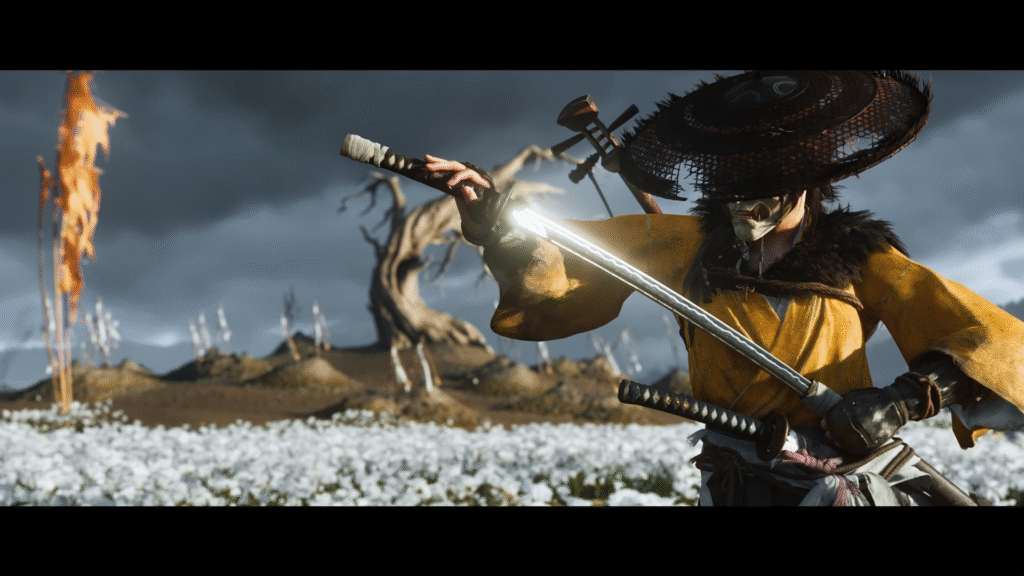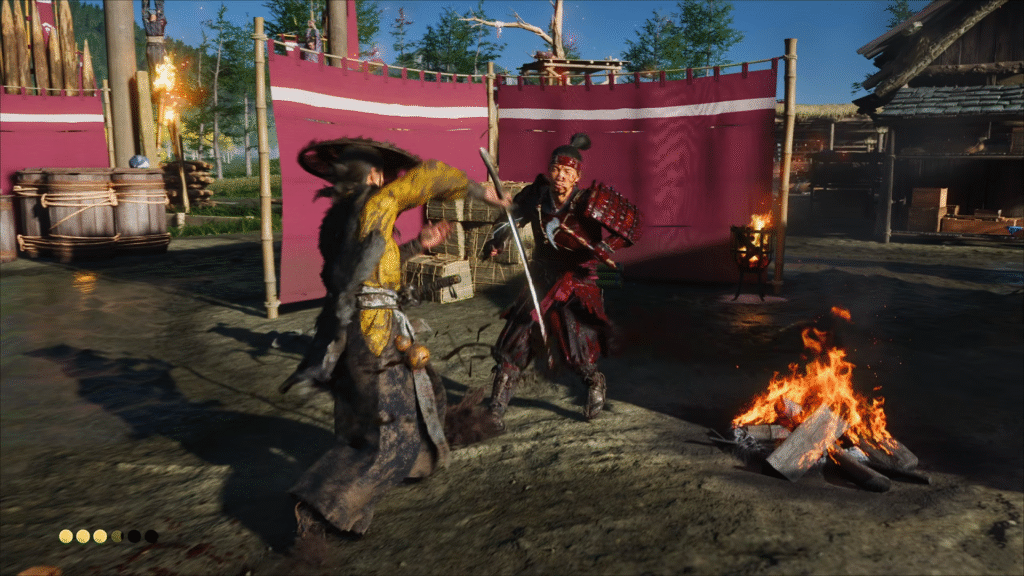Ghost of Yotei was officially shown off during the July 10, 2025, State of Play, and from the very first moments of the demo, it was clear this isn’t just Ghost of Tsushima 2. While the world of Hokkaido still shares that quiet beauty and sharp blade-edge danger of Sucker Punch’s earlier title, Yotei brings a different tone, new systems, and a lead character who walks her path. Atsu’s journey is deeply personal, and the game’s structure reflects that shift in storytelling, exploration, and combat.
With that in mind, let’s deep dive into what Gameplay changes we noticed during the Ghost of Yotei Deep Dive.
What To Expect in Ghost of Yotei

1) Flashbacks are now optional
One of the most notable changes from Ghost of Tsushima is how the backstory unfolds. Instead of occasional cutscene flashbacks like Jin Sakai had, Ghost of Yotei gives you significant control over how you experience Atsu’s past, though it’s not a completely free-form system. The game utilizes a “Dive into the Past” mechanic triggered by button press, allowing you to explore specific past events within Atsu’s story.
It’s a smart shift that keeps the present timeline tightly focused, while still letting players explore what shaped Atsu into the mercenary she is.
2) Exploration feels more natural
Gone are the question marks. Gone are the “Ubisoft-style” checklists. Yotei takes a step away from icon-chasing and leans into a more organic style of discovery, borrowing cues from Elden Ring and RDR2. Instead of simply following markers, you now rely on clues gathered from defeated enemies or found in the environment. These lead you to new quests and secrets, creating a world that feels lived-in rather than segmented.
To help with this more grounded system, you’ll use a Spyglass, which replaces Tsushima’s guiding wind. It helps you scout out distant locations or enemy positions, blending seamlessly into how the game wants you to navigate, by observing, not checking off boxes.
3) Altars, camps, and a life between battles
While exploration is more fluid, there’s still plenty to discover. Altars of Reflection replace the Shrines from the previous game, and they reward you with skill points. You can also set up camps in the game, and they aren’t just for rest, they’re functional hubs. You can cook, talk to characters, upgrade gear, and take a moment to pause. It’s a nice touch that adds rhythm to more extended travels.
You can even play music, which ties into the game’s new audio-focused features.
4) Atsu isn’t a Samurai or a Ninja

Combat in Ghost of Yotei feels fresh not just because of the weapon choices but because of who Atsu is. She’s not bound by code or tradition. Unlike Jin, who had to learn stealth and ghost tactics alongside his samurai roots, Atsu is a mercenary from the start. That gives her access to a wide variety of weapons and a more flexible combat style.
You’ll be able to use:
- Katana, Dual swords, Odachi, and Spears for varied melee options
- Kusarigama, bows, and rifles for ranged engagements
- Bombs and throwables to control space and disrupt groups
Each weapon has strengths against specific enemy types, and swapping gear mid-encounter seems encouraged. The grappling hook returns as well, now paired with the spyglass for better control in combat and exploration alike.
5) Bounties go both ways now
Atsu’s actions have consequences. As your reputation builds, a bounty is placed on your head, meaning that enemy hunters may track you down at any point in the world. It’s a smart way to make the open world feel unpredictable. But you can also collect bounties yourself, taking on outlaws for rewards.
This creates a push-pull system. You’re not just hunting. You’re also being hunted. The tension adds a layer of risk, especially during exploration, when you may not expect a fight.
6) You’re not alone
While Atsu is not part of a formal clan or army, she isn’t isolated. During the deep dive, we learned that she’ll have allies, including a mysterious wolf companion. These characters can appear at camps and help with gear upgrades or provide new dialogue depending on the choices you make.
This time, the world reacts to what you do, not just in terms of reputation, but also in how people respond to you, opening up new paths or tools as you progress.
7) Kurosawa mode returns, but it’s not alone
Visual presentation has always been a key strength of Sucker Punch, and Ghost of Yotei expands on that with three visual modes:
- Kurosawa Mode – The classic black-and-white filter inspired by the legendary director Akira Kurosawa.
- Miike Mode – Inspired by Takashi Miike, this mode uses Closer camera angles during fights, with heavier visual effects like blood, mud, and grime.
- Watanabe Mode – A relaxed visual and audio experience inspired by Shinichirō Watanabe, with original chill tracks playing as you explore.
These modes change the mood entirely, giving you space to enjoy combat, narrative, or just peaceful traversal in different ways.
This concludes our article on Ghost of Yotei Deep Dive – Gameplay changes from GoT. For more guides and game-related topics, check out Game Devourer.

